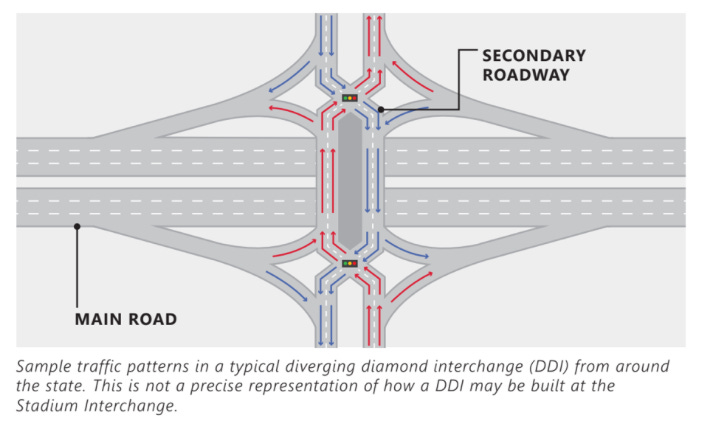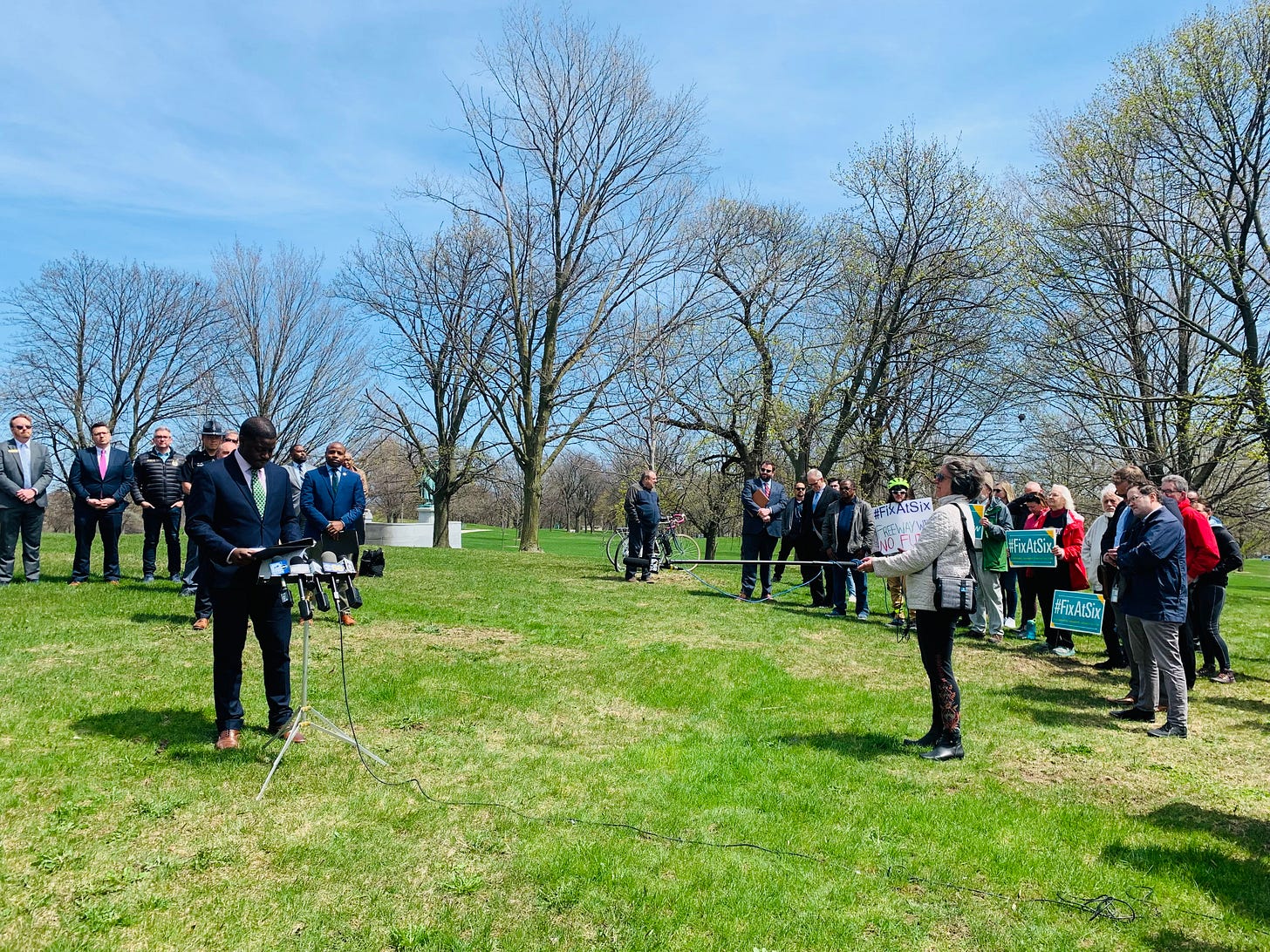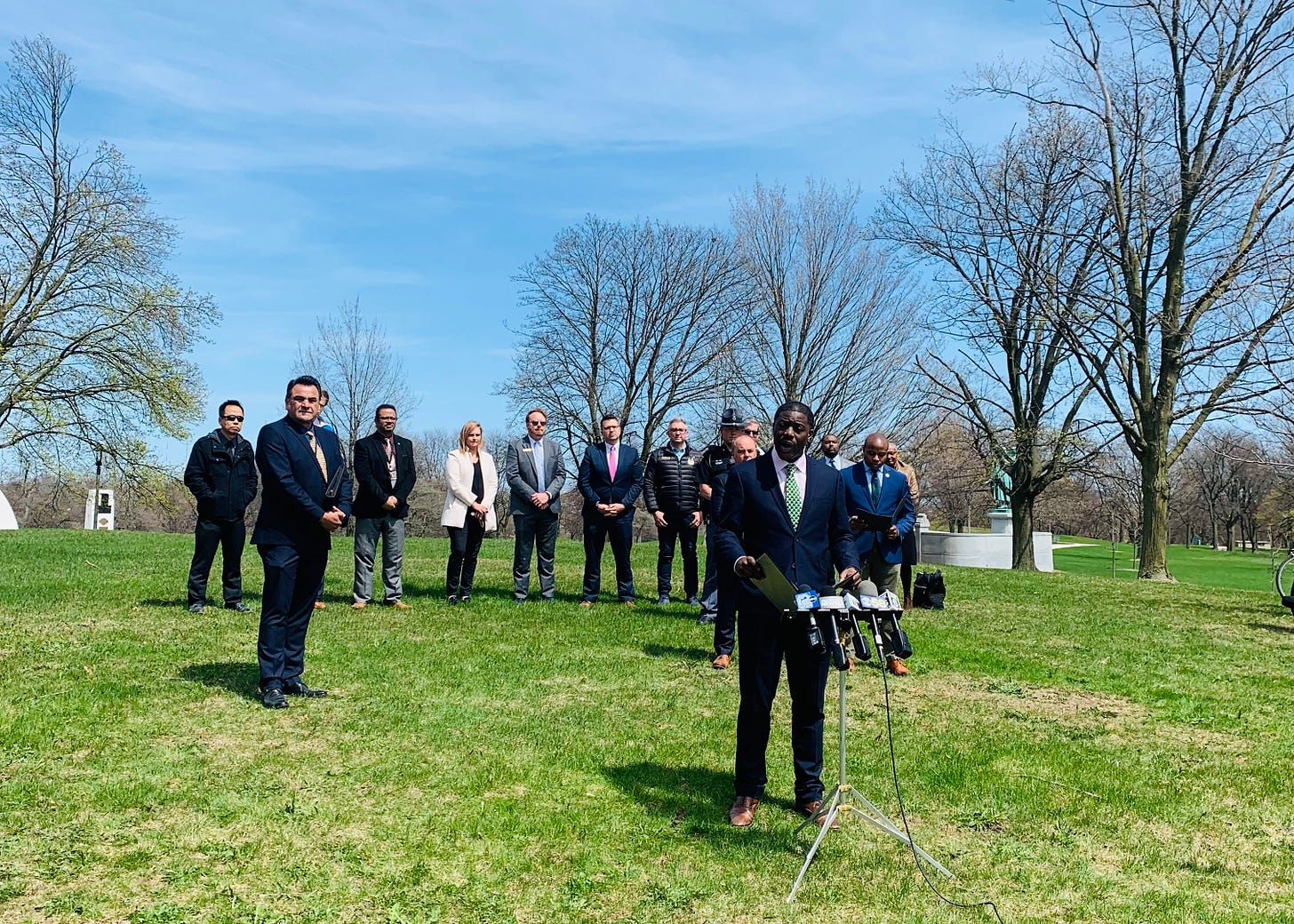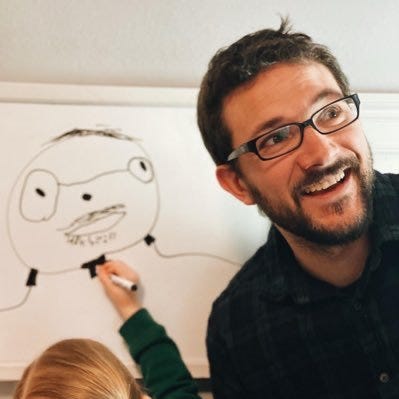Reimagining the Stadium Freeway is a Big Deal for Milwaukee
This is ultimately an investment in neighborhoods. Exactly what Milwaukee needs.
The Recombobulation Area is a six-time Milwaukee Press Club award-winning weekly opinion column and online publication written and published by veteran Milwaukee journalist Dan Shafer. Learn more about it here.

Milwaukee is one of the most segregated large metro areas in the nation. This continues to be one of our city’s top problems. So when a major announcement is made with the goal of reconnecting historically divided communities and combating the segregation that has been so prevalent and problematic in Milwaukee neighborhoods, it is a tremendously big deal.
Less than a month after Milwaukee elected its first Black mayor and on the two-year anniversary of Milwaukee County’s first Black county executive’s first day in office, the state, county and city came together to announce a new study to reimagine the future of the Stadium Freeway on Milwaukee’s west side. Instead of reinforcing the divisions this highway has brought to neighboring communities by rebuilding it in its current footprint, this new effort is aiming to bring people together in this all-too-divided city.
What was formally announced on Wednesday, May 4, at Washington Park was a new feasibility study to reexamine the future of the Stadium Freeway – the stretch of Wisconsin Highway 175 North from Wisconsin Avenue to Lisbon Avenue. The study will be funded by the Wisconsin Department of Transportation (WisDOT), is estimated to cost $2-3 million, and will take roughly a year and a half.
The end goal of this new effort is clear: To find the best way to convert this 1.5-mile stretch of road from a freeway to a boulevard.
This is nothing short of a major win for Milwaukee. A collaborative effort between state, county and city to invest in a project that gets at the heart of one of the biggest problems the city and region faces needs to be celebrated. This project has the potential to bring truly meaningful change to this city. This is outstanding news.
“We have a chance to update our transportation infrastructure, and dismantle the barriers that divide communities and reinforce inequality,” said County Executive David Crowley, who called the announcement “historic,” in his remarks at the press conference.
“(This study) affords our city the opportunity to change the previous legacies that have been deeply rooted in Milwaukee,” said Mayor Cavalier Johnson in his speech. “Legacies such as division and disruptions that highways have caused as they've been constructed here in our city. Highways like this, (State) Highway 175, have left permanent scars on the city of Milwaukee, from the homes in the communities that were demolished that were once here to the disconnection that our neighborhoods feel when you have highways that bisect. It's long past time that we need to ensure that the infrastructure that we have here in the City of Milwaukee works for the City of Milwaukee, first and foremost. “
The study, which promises to include “robust input from the community,” said WisDOT Secretary Craig Thompson, comes with the goal of finding a way to “reconnect communities that have been divided in the past.”
This is exactly the kind of project Milwaukee should be seeking out and taking on. This is ultimately an investment in neighborhoods. Neighborhoods that have been needlessly divided by an unnatural physical boundary that is doing more harm than good. Milwaukee needs to be rebuilding its infrastructure for a more equitable future, and converting the Stadium Freeway to a boulevard can be an important step toward accomplishing that goal.
A reimagined boulevard corridor can be a place to promote economic development, to build new housing this city desperately needs, to invest in more public transit and multi-modal transportation infrastructure, to welcome new businesses, and to invest in amenities like Washington Park, which should be a place in this city where people can safely come together. There is so much potential in this city just waiting to be unlocked. This can be a catalyst for so much more.
Crowley and Johnson should be commended for championing this project and partnering with the state to move it forward. Their leadership on this issue has been so important. As has the leadership of State Rep. Evan Goyke, whose district includes the Stadium Freeway, and who has been advocating for this freeway spur to be reimagined for more than a decade (Note: We had a quick chat with Goyke after the press conference and subscribers can read that Q&A here).
WisDOT should be commended for its flexibility in leadership on this project, too. While we’ve been particularly critical of the department and its proposals for the I-94 East-West and Stadium Interchange project here at The Recombobulation Area, the fact that they are responding to criticism and making meaningful changes reflects well on WisDOT under the leadership of Secretary Craig Thompson as well as Gov. Tony Evers and his administration.
Because it was just over a year ago when WisDOT announced that it would be reevaluating the proposed highway expansion project by undertaking a Supplemental Environmental Impact Statement (SEIS), something that freeway expansion opponents and local leadership – including both Crowley and then-Mayor Tom Barrett – had been advocating for. That process has helped reset the conversation, allowing for WisDOT, state and local leaders, and most importantly the people of this city and region to take a step back and ask: Is there a way we could do this differently?
As recently as December, the I-94 East-West and Stadium Interchange project had been careening toward an undesirable outcome where this billion-dollar project would look much the same as it has. The narrow scope of the vision for this project displayed a startling lack of creativity.
But now, in addition to the work being done to study a new path forward for the Stadium Freeway, WisDOT leaders are taking another look at the Stadium Interchange, too. At the announcement press conference, Thompson said “you will see changes” to plans.
It stands to reason that if changes are being made to 175, that changes could be made to the larger I-94 East-West project, as well as the Stadium Interchange that is the “main driver” of the projects overall cost, currently estimated at more than $1.1 billion for both six-lane and eight-lane options.
With that, in the latest WisDOT newsletter on the East-West Corridor Study, WisDOT said it is “evaluating new traffic forecasts,” which have “led to additional analysis of the Stadium Interchange and a determination that a diverging diamond interchange warrants further study.” This means an alternative plan for that interchange will be introduced.

New public involvement meetings are now planned for June 14 (at State Fair Park) and June 15 (at Marquette University High School), both from 4 p.m. to 7 p.m. There, people will be able to see and discuss those updated plans.
The likely outcome for larger plans for I-94 still include a widened freeway, but this process is still ongoing, and WisDOT is demonstrating an ability to adapt and respond to public feedback on key components of this project.
Engaging with the local residents is going to be an important part of determining what's next for the I-94 project and with the 175 study.
Peter Burgelis, the newly elected county supervisor whose district includes the Stadium Freeway and Stadium Interchange, campaigned on converting Highway 175 to a boulevard.
“Freeways are physical barriers, but it's also a psychological barrier,” he said in an interview with The Recombobulation Area.
He plans to be active in community conversations on this issue as this study unfolds.
“I want to make sure that (WisDOT) listens to every neighborhood adjacent to and around 175 North, because those are the opinions and those are the people that matter with this project,” he said in an interview with The Recombobulation Area, adding that “I will have as many District 15 community meetings that I need to to make sure that every voice is heard.”
Felesia Martin, county supervisor in the 7th District (Sherman Park, northwest side), said these public conversations that will come as part of this study will be important, and is encouraged by the collaboration between the state, county and city.
“What I really want to focus on is making sure there is community engagement and getting the residential input,” she told The Recombobulation Area at the event. “I just want to see us working together.”
The Recombobulation Area’s coverage of the Stadium Freeway and the I-94 East-West/Stadium Interchange project has been extensive. Last week, we broke the news that the Stadium Freeway’s future would be reexamined. Last year, we published a multi-part series on the billion-dollar proposed highway expansion in Milwaukee called “Expanding the Divide.” That series has won three Milwaukee Press Club awards, including one for Best Single Editorial for the column, “Tear Down the Stadium Freeway in Milwaukee.”

Crowley and Johnson’s speeches at the event were particularly notable.
Crowley has put promoting racial equity at the forefront of his agenda as county executive, and discussed that aspect of this project in his remarks.
“For a long time I recognized highway 175 is one of those divides that separates our community from one another,” he said. “It separates residents from both opportunities and amenities.”
He added: “And in the 60 years since the section of this roadway was finished, our area has changed tremendously. And more importantly, we've learned a lot about how decisions of the past have harmed communities in ways that we still feel today. Those decisions use transportation infrastructure to reinforce segregation, to divide our communities and isolate people from economic opportunity. In order to move forward, we have to acknowledge that individuals make choices to build freeways through black and brown communities…and we continue to feel the effects of those decisions today. We can see that race as well as zip code, explain which communities receive the benefits of our transportation system and infrastructure, and which communities were forced to host a burden. But everyone speaking here agrees that our transportation infrastructure can use an update. But it doesn't have to come at the cost of communities of color.”
Johnson, who campaigned as an “urbanist,” also emphasized how the use of the freeway in its current form is “solely for the use of automobiles,” and wanted to see that change.
“A transformation of this area will unlock additional economic and commercial value, reconnect local neighborhoods along this route and provide opportunities for multimodal transportation infrastructure, not just infrastructure for speeding cars,” he said. “These are the exact sorts of projects that my administration will continue to pursue where it makes sense to do so. Now it's time to correct the infrastructure flaws of our predecessors.”
So now, the work begins. Part of what’s next will include seeking federal funding through the Bipartisan Infrastructure Law and the “Reconnecting Communities” grant that would presumably go toward funding this project, leaders said. This new pilot program is already being put to work in Detroit, after Michigan Gov. Gretchen Whitmer applied for these funds for I-375 to create an “urban boulevard.” That project will certainly be one for Milwaukee to watch and learn from.
That’s all part of the discussion of what’s next, but the major takeaway from this week’s announcement is this: This is a big, big deal. Reimagining the Stadium Freeway and converting it to a boulevard is the right move. It’s going to be important for the community to come together to get every last detail of this project right, but the big picture here is one of a genuine game-changer. This could pave a dynamic path forward, integrating and developing Milwaukee neighborhoods, and in turn taking a major step toward addressing some of the biggest issues this community faces.
Get excited, Milwaukee.
Listen to Dan Shafer discuss the Stadium Freeway project with Steve Scaffidi on 620 WTMJ, and on “Dueling Tangents with Luke and Bryan” on WAUK 540 AM, The 'Sha and Devil Radio 92.7 FM.
Dan Shafer is a journalist from Milwaukee who writes and publishes The Recombobulation Area. He previously worked at Seattle Magazine, Seattle Business Magazine, the Milwaukee Business Journal, Milwaukee Magazine, and BizTimes Milwaukee. He’s also written for The Daily Beast, WisPolitics, and Milwaukee Record. He’s won 13 Milwaukee Press Club Excellence in Journalism Awards. He’s on Twitter at @DanRShafer.
Subscribe to The Recombobulation Area newsletter here and follow us on Facebook at @therecombobulationarea.
Follow Dan Shafer on Twitter at @DanRShafer.



